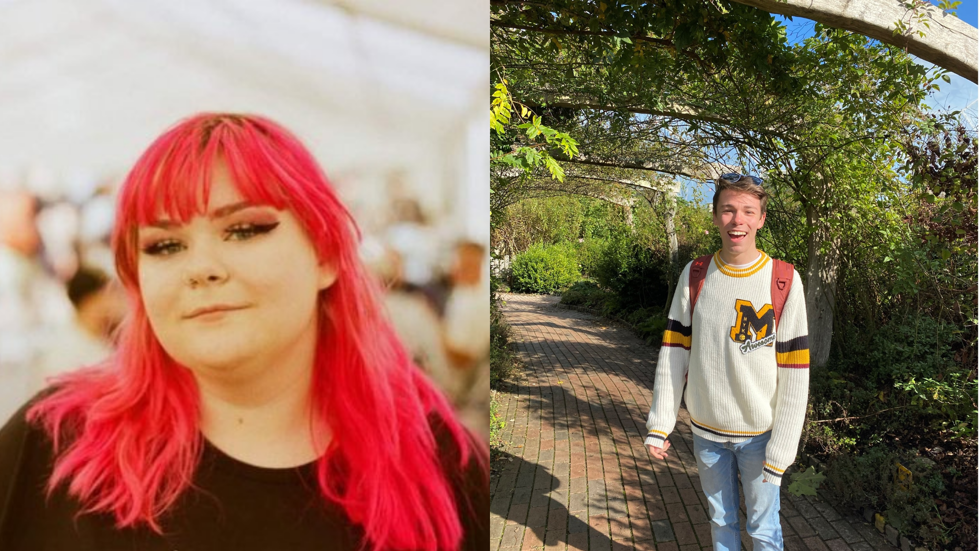Do you love history, art and culture? Have you ever thought about turning that passion into a career?
Whether you want to work directly with visitors or make things happen behind the scenes, there’s lots of brilliant jobs on offer in the world of museums and galleries. With over 1800 museums across the UK, there’s also many different routes into the sector!
We sat down with two members of the Kids in Museums Youth Panel to chat more about the journeys that led them to a career in heritage. Read on to find out more about where they started, where they are now – and their top tips for getting into the sector!

Hello! Can you tell us a bit about you and your current role?
Iris: Hello! I’m Iris and I’m a PhD researcher at the University of Westminster. I’m also a community archivist/curator for the Estonian House, Bradford.
For my PhD, I’m working to develop new guidance for museums on how to tell stories about deafness, disability, neurodivergence and mental health in ethical and inclusive ways. As an archivist, I look after a collection of around 80 years of Estonian and Baltic refugee and migrant history in the UK.
Connor: Hi, I’m Connor. My current role is with the National Trust - I’m the Senior Visitor Experience Officer at Lyveden in Northamptonshire, which is an unfinished Elizabethan formal garden and lodge. The property also has links to the Gunpowder Plot, which is really cool!
I look after the visitor-facing side of the site, managing the welcome and reception team, the programming and events team, the second-hand bookshop and many of our fantastic volunteers. It's quite cliche to say, but no two days are ever the same for me. Sometimes I’m writing rotas and risk assessments, and other times I am working with a school group. I wouldn't have it any other way!
What kind of journey have you taken to get to the job you have now?
Iris: I started out by volunteering in my secondary school library, sorting out old books!
Later, I volunteered at a literary house at university. This helped me develop hands-on heritage skills, including conservation cleaning, visitor assistance, retail and more.
I applied for my first big heritage role after graduating in 2022. It was called the Curating for Change Curatorial Programme, a specialist role as a curator looking at disability history, designed to support disabled curators to enter the museum sector. I used all those volunteering skills to really sell myself and did a video application that I both cringe at and feel oddly proud of to this day!
Connor:
I took quite a traditional route to get to my current role. I left school and went straight to university to study Medieval History and Archaeology, going on to complete a Master’s degree in Museum and Gallery Studies. I learned a lot about researching, analysing and thinking critically through my undergraduate degree, and about object conservation, curation and exhibition management from my master’s. I then began a role in museum education at the fantastic Creswell Crags Archaeological Park before moving to the National Trust to continue building my career.
It is worth saying that there are lots of internships, assistant roles and apprenticeships in the sector which are another fantastic way to gain experience whilst also getting paid!
Were there any resources you found particularly helpful along the way? Is there anything you know now that you wished you’d known when you were starting out? Any words of advice?
Iris:
Following museum professionals directly on Twitter/X and LinkedIn who work at organisations with collections/stories that I’m interested in has been massively impactful.
It’s interesting seeing what individual people are doing and thinking, rather than just what the museum or gallery they work for is sharing on social media or their website. These people often share opportunities and jobs with their online communities, so it’s a good way to find things you might otherwise have missed!
Check out your local museums, galleries, libraries and archives and find out whether they have a Youth Panel or youth projects. Kids in Museums even has a Youth Group Directory you can search through. Emailing or going in and saying “Hi, what projects do you have for young people to get involved in?” can make all the difference. Volunteering means you can try all sorts of different things and find what you truly enjoy and where you excel.
Your thoughts and experiences are so valuable, and you can make a real difference. You are the future, museums need you!
Connor:
Here’s my top tips for anyone interested in working in museums and heritage:
- Say yes to as much as you can. I know this isn't always easy, but the more strings you can add to your bow, the better. Experience of looking after a social media account, organising events or working with volunteers can have a big impact in interviews as it shows you to be a well-rounded candidate.
- Deep dive into job websites. My favourites were the University of Leicester Museum Jobs Board, Arts Jobs, GEM (Group for Education in Museums) and AIM (Association of Independent Museums). You will be surprised how many roles you are qualified to do!
- Stay true to yourself. The heritage sector isn't always the easiest to break into or progress quickly through. In my experience, following my passions has given me a huge amount of job satisfaction. For me, this is engaging the public and working with younger audiences. This has really focused any job searches and ideas on the future - and has also meant occasionally taking a leap of faith to try something new.
To find out more about careers museums and galleries go to https://kidsinmuseums.org.uk/resources/a-guide-to-careers-in-museums-and-galleries/